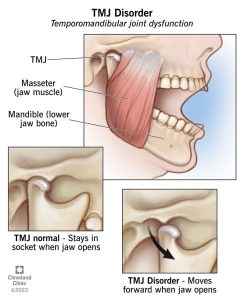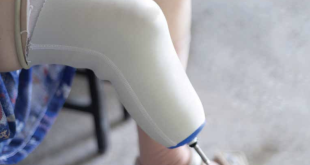 Dr Prenit K Pokhrel
Dr Prenit K Pokhrel
He completed his BDS from BPKIHS, Dharan, and his MDS in Oral and Maxillofacial Surgery from Manipal, India. He currently serves as an Associate Professor and the Dean at Karnali Academy of Health Sciences, Jumla. With extensive experience in oral and maxillofacial surgery, Dr. Pokharel is committed to improving healthcare access in remote regions of Nepal. His contributions to research, education, and patient care have made a significant impact in the field of dentistry and beyond.
Temporomandibular Joint
Temporomandibular Joint(TMJ) is the movable joint, it helps in opening and closing of the mouth. The upper most part of the mandible, that is the condylar head which is somewhat round, goes and stays in the depression of the temporal fossa to form this joint. The muscles of mastication are primarily responsible for the movement of this joint. The ligamentous capsule, articular disc and retrodiscal tissue allow for the smooth joint movement.
 Temporomandibular Disorder (TMD)
Temporomandibular Disorder (TMD)
Temporomandibular Disorder (TMD) has been defined as “a group of musculoskeletal conditions that involve the temporomandibular joints (TMJs), the masticatory muscles and all associated tissues.” Majority of the pain in oral and facial region are attributed to dental origin but TMD is other major cause for orofacial pain without dental origin. Temporomandibular Disorder (TMD) are broad group of clinical problems that involve multiple components of structure in and around the condylar region that is in the region of the joint that opens and closes the mouth. It includes the surrounding masticatory muscles, Temporomandibular Joint (TMJ), surrounding bony and soft tissue components and combining all the problems in these structures. It is believed that more than 5% of the world population suffer from TMD problem. However, we lack the separate study in the Nepalese population. The peak occurrence age is believed to be 20 to 40 years, females are affected more than male, and premenopausal women are thought to be affected more than postmenopausal females. It may be due to hormonal influence and study in animals and humans have suggested that sex hormones play a role in TMJ dysfunction and cartilaginous breakdown. The diagnosis of TMD is most often based on patient history and physical examination.
Classification of Temporomandibular Disorder (TMD)
The classification of TMD is simple, it is according to whether the involvement is within the joint space (that is intra articular) or if the involvement is outside the joint space that is around and in the surrounding musculature (extra articular). The musculoskeletal conditions account for almost 50% of the cases of TMD. Among the Intra-articular cause Articular disc displacement leading to discrepancy in condyle–disc relation is the most common cause.
Differential Diagnosis
There are many conditions causing pain that mimic the pain similar to TMD. A clinician should always be able to differentiate the pain due to TMD and other conditions. Dental caries or abscess, Oral lesions (like Herpes zoster, herpes simplex, lichen planus, oral ulcers), conditions arising from functional overuse of masticatory muscles (clenching, bruxism, excessive chewing, spasm), trauma or dislocation, maxillary sinusitis, salivary gland disorders, trigeminal neuralgia, postherpetic neuralgia, glossopharyngeal neuralgia, giant cell arteritis, primary headache syndrome and pain associated with cancer are some of the differential diagnosis for TMD.
Evaluation
Diagnosis
The diagnosis of TMD is largely based on history presented by the patient and the clinical examination. The clinical symptoms of TMD include limited mouth opening, pain in the muscles which are responsible for chewing foods, pain in temporomandibular region (TMJ), pain during jaw movement, clicking sound when opening or closing of mouth and sometimes the mouth may deviate to the other side while opening. The most common signs and symptoms of TMD presented by a single examiner after 25 years of research were Facial pain (most common), ear discomfort, headache, and problem with jaw function. Other symptoms the study suggested were dizziness or neck, eye, arm, or back pain. If the pain persists for more than three months we call the condition chronic TMD.
The physical findings that contribute to the diagnosis of TMD include some of the following, but one should not be limited to these findings only. The findings are decreased and abnormal mandibular movement, tenderness of muscle of mastication, signs of bruxism, and neck or shoulder muscle tenderness. Malocclusion contributes to the TMD so clinician should mandatory access the malocclusion and see whether it is contributing to the TMD. Cranial nerve abnormalities should not be attributed to TMD.
A clicking sound is often related to disc displacement and crepitus is associated with articular surface disruption which is common in osteoarthritis. Tenderness to palpation and deviation of the jaw while opening are suggestive of TMD.
A simple method to screen for painful TMDs is to use a six item self-complete questionnaire developed in tandem with Diagnostic Criteria for TMD. This method is believed to have 99% sensitivity and 98% specificity for painful TMDs. This questionnaire is freely available on the RDC/TMD consortium website (www.rdc-tmdinternational.org/OtherInstruments/TMDPainScreener.aspx). A score of 3 or more is indicative of a positive screening for TMD.
Imaging
X-ray can assist in the diagnosis of TMD but they can never be a substitute for history and clinical examination. When History and Clinical examination are equivocal, Imaging is a useful assistance aid. One should always start with plain radiography (transcranial and transmaxillary views) or panoramic radiography. Computed Tomography is superior to plain radiography for evaluation of bony morphology. Magnetic resonance imaging is the optimal choice to evaluate joint status in patients with signs and symptoms of TMD. However, we must also bear in mind that false positive results among asymptomatic patients with MRI is also common. Hence, MRI is reserved for symptomatic patients in whom conservative therapy has been unsuccessful or in those with suspected internal joint derangement. Ultrasonography (USG) is a non-invasive, economical, dynamic technique to diagnose internal derangement of the TMJ when MRI is not available.
Treatment
It is believed that only 5 % to 10 % of the patients of TMD require treatment. The symptoms spontaneously resolve in around 40% of patients. Multidisciplinary approach is needed for the successful management of TMD. Surgical interventions are reserved for patients who do not respond well to multiple conservative therapies.
NonPharmacologic Management
Recommended initial treatment is supportive patient education. Supportive measures include jaw rest, soft diet, moist warm compresses, and passive stretching exercises. Treatment of underlying conditions that is resulting in TMD yields successful management of TMJ.
Acupuncture is useful in treatment of TMD caused by Myofascial muscles. Patients should also be counseled on behavior modifications such as stress reduction, sleep hygiene, breakage of parafunctional habits, and asked to avoid over stressing the mandibular movements.
Why is psychological management of TMDs important?
The patient’s beliefs, expectations, emotional state, family environment, and cultural background can all play a role in the onset, development, and maintenance of persistent pain. The use of patient centered communication skills, promoting patient self efficacy, and providing positive feedback on patients coping efforts can all enhance patient motivation to engage in self management approaches. Encouraging patients to refrain from falling into the trap of seeking “quick fixes” for complex problems and assisting and supporting them to develop and expand their own coping resources, offers a better long term solution.
Pharmacologic Management
Non-Steroidal Anti Inflammatory Drugs(NSAIDs) are often the first line of drugs used to treat acute pain associated with TMD, these drugs are generally used for a period of 14 days. Naproxen among other NSAID’s has been proven to reduce TMD pain more effectively. Muscle Relaxant can be prescribed along with NSAID’s if there is evidence of muscular component involvement. Similarly, Tricyclic Antidepressants drugs (amitriptyline, desipramine etc.) can be prescribed along with NSAIDs in the patients with chronic TMD.
Occlusal splints and Adjustments
The occlusal splints help in reducing the degenerative forces on TMJ, articular disc and dentition. These devices benefit people with severe bruxism and night teeth clenching habits.
Surgical treatments
Surgical treatments are reserved for correction of anatomic or articular abnormalities. Surgical treatments include arthrocentesis, arthroscopy, discectomy, condylectomy, and total joint replacement.
Conclusion
Temporomandibular Disorder (TMD) is a prevalent yet often overlooked condition that significantly impacts the quality of life. A thorough understanding of its causes, symptoms, and management strategies is essential for timely diagnosis and effective treatment. While most cases can be managed through conservative approaches, a multidisciplinary treatment plan involving non-pharmacologic, pharmacologic, and, when necessary, surgical interventions ensures better patient outcomes. Additionally, addressing psychological factors and promoting patient self-management are crucial for long-term relief.
 Medicosnext
Medicosnext




